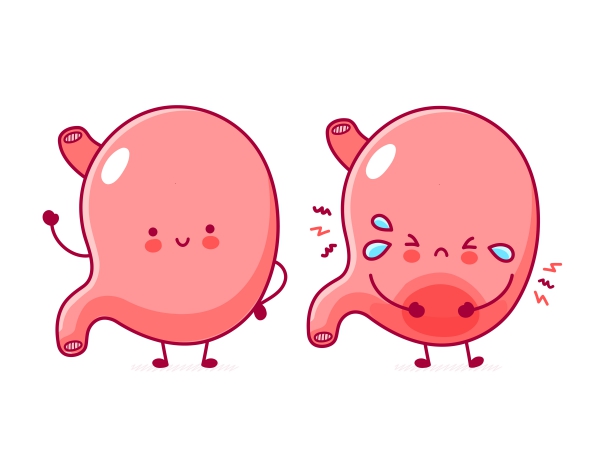What is hiatal hernia?
Hiatal hernia is a condition in which part of the stomach protrudes through the diaphragmatic esophageal hiatus. The esophagus is a tube that connects the mouth and the stomach through which food travels. It runs through the diaphragm just before reaching the opening of the stomach. The diaphragm is a thin muscular layer that separates the chest cavity from the contents of the abdomen. The opening through which the esophagus passes through the diaphragm is known as the diaphragmatic hiatus. In hiatal hernia, the initial part of the stomach passes through the hiatus which may or may not result in symptoms. It is a condition that is closely related to gastroesophageal reflux disease.
Most of the time, hiatal hernias present without any symptoms and are found incidentally. Very rarely, it arises as an emergency requiring prompt treatment. It is a condition that arises most commonly in Western countries. This may be due to the trend in consuming foods that lack fibre. Its prevalence increases with increasing age with more than 70% of patients being aged above 70 years. This may be explained by the weakening of muscles. It is also most common in women compared to men.
There are 2 types of hiatal hernia namely sliding hernia and paraesophageal hernia. Sliding hernia is when both the top part of the stomach and the lower part of the esophagus protrude above the diaphragm into the chest cavity. It is the most common type of hiatal hernia. On the other hand, paraesophageal hernia is when the top part of the stomach prolapses above the diaphragm into the chest cavity. It rarely occurs but can lead to potentially serious complications.

What are the causes of hiatal hernia?
Hiatal hernia usually occurs following weakening of muscles that allows your stomach to protrude through the diaphragm. The exact mechanism by which this happens is not clear. The following may contribute to the development of a hiatal hernia:
- Increasing age is associated with a weakening of muscles, including the diaphragm
- Injury which may be due to trauma or surgery
- Being born with defects in the diaphragm
- Being pregnant can add pressure on the diaphragm, pushing abdominal contents against it
- Persistent increased pressure in the abdomen such as during coughing, vomiting, straining or lifting heavy objects
- Being aged 50 years and above
- Being obese
What are the symptoms of hiatal hernia?
In the majority of cases, hiatal hernias do not present with any symptoms. It is usually found incidentally during exploratory procedures by radiologists or gastroenterologists. However, in some cases, hiatal hernias may present with the following symptoms:
- Heartburn (burning sensation in the chest)
- Regurgitation of food
- Acid reflux
- Difficulty to swallow
The above symptoms are similar to gastroesophageal reflux disease (GERD) symptoms as the two conditions are closely related.
Other symptoms include:
- Chest pain
- Voice changes
- Sore throat
- Unexplained cough
- Nausea
- Retching
- Breathing difficulties


How is the diagnosis of hiatal hernia made?
As mentioned earlier, the majority of cases do not present with any symptoms. They are usually discovered incidentally, meaning, during certain procedures carried out for other purposes. These procedures include:
- Barium upper gastrointestinal series: In this procedure, you are required to swallow a barium solution which is a chalky liquid that will flow through your gastrointestinal tract, coating it as it goes. X-rays of your upper digestive tract are then taken showing the outline of your esophagus and stomach.
- Upper endoscopy: In this procedure, a special thin tube-like apparatus with a camera on its end is inserted down your throat to visualize your esophagus and stomach.
- Esophageal manometry: In this test, the rhythmic muscular contractions of your esophagus are measured. This test is however rarely used to make the diagnosis of hiatal hernia due to its low sensitivity.
How is hiatal hernia treated?
The most common cause of symptoms in hiatal hernia is due to acid reflux. Therefore, in these cases, the goal of treatment is to prevent the reflux of acid contents and reduce acid production by your stomach. The following helps in the treatment of acid reflux:

- Use of antacids: These medications work by neutralising acid found in the stomach hence alleviating symptoms. They provide quick relief, however, they should not be overused as they can cause diarrhoea or kidney disorders.
- H2 receptor blockers: These medications work by decreasing acid production. Some examples include cimetidine, famotidine and nizatidine.
- Proton pump inhibitors: These medications also work by decreasing acid production. They are more effective compared to H2 receptor blockers. They also give the esophagus enough time to heal. Some examples include lansoprazole and omeprazole.
In some cases, surgical treatment may be needed to manage hiatal hernia. This should be considered in people in whom medications are not helping or those who have severe complications. The surgery involves placing the stomach back into its normal position and partially closing the hiatus to make the opening smaller. This may be done during an open or laparoscopic surgery. In a laparoscopic surgery, small holes are made in your abdomen to allow insertion of special surgical tools and a camera. The surgery is then performed and followed on a monitor where the abdominal contents are clearly visualized.
Lifestyle modifications are also recommended including:
- Stop smoking
- Lose weight if you are overweight or obese
- Eat at least 2 to 3 hours before going to bed
- Elevate the head of your bed
- Avoid certain foods including chocolate, onion, garlic, mint, fatty foods, tomato sauce, caffeine and alcohol

Prognosis
Some hiatal hernias tend to increase in size with time until, in some cases, the entire stomach is found inside of the chest cavity. This increases the risk of complications of perforation, strangulation and incarceration. Strangulation and incarceration is when the stomach is squeezed leading to deprivation in blood circulation. This, if left untreated, can result in the death of the tissues and complete loss of the stomach or even death.

Source:
Qureshi, W., 2016. Hiatal Hernia
Qureshi, W., 2016. Hiatal Hernia Treatment & Management
Kahrilas, P., 2020. Hiatus hernia
Kaiser LR, Singal S. Diaphragm. In: Surgical Foundations: Essentials of Thoracic Surgery, Elsevier Mosby, Philadelphia, PA 2004. p.294.
Peridikis G, Hinder RA. Paraesophageal hiatal hernia. In: Hernia, Nyhus LM, Condon RE (Eds), JB Lippincott, Philadelphia 1995. p.544.




